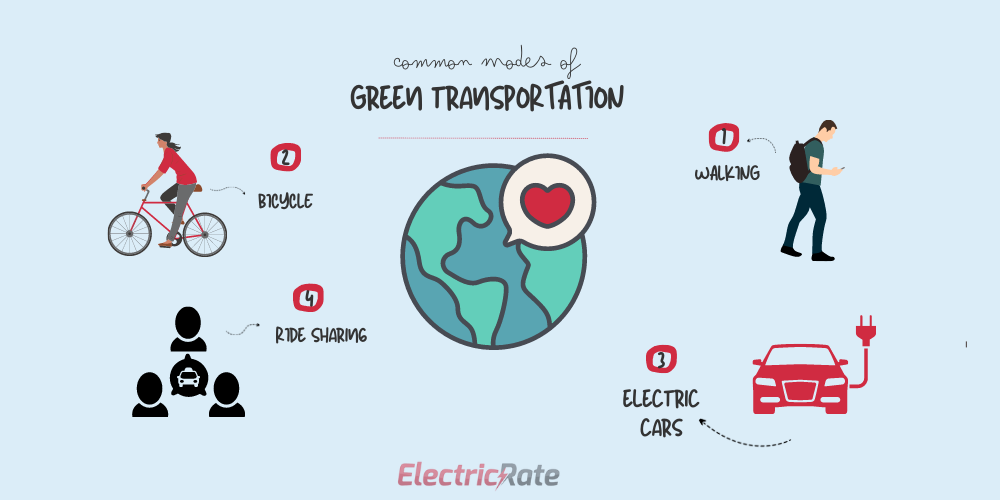Innovative Alternatives to Traditional Transportation

Even during ancient times, humans are always on the move. They walked, rode animals, or devised simple wheeled vehicles to go from place to place. This love for mobility has increased now that advances in technology made it possible for people to reach the farthest regions of the globe.
No wonder then that traveling has become an essential part of our lives. Yet, no matter how vital transportation may be, it also brings forth a host of problems. The two most significant are environmental degradation and global warming.
Burning gasoline and diesel fuel leads to greenhouse gas emissions that contribute to global warming. Around 29% of the country’s greenhouse gases come from transportation. That’s according to the Environmental Protection Agency. Also, the combustion of the fossil fuels used for the different modes of transport cause pollution.
We may not be able to go without transportation, but more environmentally-friendly ways to travel exist. These are called green transportation.
What is Green Transportation?
Green transportation, also called sustainable transportation, refers to a low-carbon way to travel. It involves using modes of transport that create low pollution. These modes of transport usually rely on renewable sources. As such, they produce negligible greenhouse emissions.
Green transportation modes don’t release significant amounts of earth-warming gases. As a result, they have little impact on the environment.
What Are The Importance Of Green Transportation?
Green transportation helps reduce the amount of harmful greenhouse gases that get into the atmosphere. That’s its main importance. But aside from that, it also offers certain advantages.
Reduces The Number of Trips
There’s a method of shipping goods over the road called Less Than Truckload or LTL. It’s a service offered by parcel delivery companies and it involves moving small batches of goods instead of a full load. That means more frequent trips, thus leading to more greenhouse gas emissions.
Providers of green or sustainable transportation combine several smaller shipments into one. This leads to fewer trips and lower gasoline consumption and emissions.
Increases Efficiency Through Modifications
Efficiency doesn’t just happen. To achieve the goal, modifications to existing structures need to be done. For example, changing a truck’s body and using specialized tires will improve fuel efficiency.
A fuel-efficient vehicle burns less gasoline or diesel. This means it spews less carbon dioxide and other toxic gases.
Contributes To Sustainable Economy
Utilizing green transportation will attract more investments in the sustainable transportation sector. In turn, the industry will grow, thus creating more jobs. This growth will help build a sustainable economy and reduce the socio-economic gap.
Going green in our transport mode also lessens over-reliance on fossil fuels. Relying on such fuels drains the economy due to the high production cost.
Reduction In Air Pollution
Conventional modes of transport use fossil fuels. Such fuels release vast quantities of earth-damaging gases and particulates. Green transportation aims to cut back the amount of gases and particulates that go into the air. It achieves this goal through the following methods.
Following Air Quality Requirements
Green transportation aims to cut back the emissions of harmful gases. It achieves this goal through the following methods.
- The addition of side skirts to enhance aerodynamics, which increases fuel efficiency.
- Use of low rolling resistance tires to minimize energy waste.
- Reliance on alternate power sources. These sources include battery packs, diesel power, and electrical hookups.
- Less idling time, which requires drivers to shut off the engine when they’re not on the road.
Reduce Greenhouse Emission
There are two ways vehicles can reduce their environmental impact. They are:
- Relying less on fossil-fuel-based gasoline and more on green fuel that ejects fewer harmful emissions.
- Using a Diesel Particulate Filter, a device that traps and stores particulate matters like soot and ash.
Modes of Green Transportation
Transportation is one of the top contributors of greenhouse gases in the country. But giving up all modes of travel is impossible and downright impractical. The obvious solution is to turn to more eco-friendly transport options.
Here are some of them:

Walking
This is the most basic way to get around. Needless to say, walking doesn’t need the use of fuel. As such, it has zero impact on the environment and that is one of its advantages. Due to traffic congestion, walking can sometimes even get you to where you want to go faster than public transportation.
But walking is not the most convenient way to get to our destination. It’s tiring, for one. Moreover, walking requires a lot of energy. If you have to carry some load, it won’t be the most efficient means of traveling.
Another disadvantage of walking is the risk of getting injured from being hit by a vehicle. Pedestrian deaths in the U.S. have been surging despite the pandemic that forced many Americans to stay off the road.
Bicycle
Biking is another earth-friendly and heart-healthy form of transportation. Like walking, it employs muscle power instead of ecologically harmful fuel sources. This makes biking emissions-free. Riding also helps you save money since you don’t have to pay for the cost of fuel.
On the downside, biking can be risky, especially during inclement weather. Moreover, many areas of the country lack bicycle lanes. This puts bikers in danger of getting hit by motorized vehicles.
Electric Bicycle
An ordinary bicycle runs purely on muscle power and requires constant pedaling to keep it moving. Its electric counterpart is still muscle-powered but has been modified to include a small electric engine. This engine gives your pedaling a boost. In this way, light pedaling can propel the bicycle forward with a little less force than what a non-electric bike requires.
Like a conventional bicycle, an electric one emits no harmful gases. It also offers the advantage of working with less muscle power, thus helping you save your strength.
However, because of the addition of an electric motor, this bicycle type has a more complex working mechanism than its traditional counterpart. As such, repairing it is not as straightforward. The engine can also malfunction, which adds to the repair costs.
Electric Motorcycle
This type of transport relies entirely on stored electricity coming from storage batteries. Because no fuel combustion occurs, this vehicle produces no noise or carbon emissions.
An electric motorcycle frees you from some maintenance costs associated with a fossil-fuel-powered motorbike as well. These expenses include changing oil, time belts, spark plugs, and the like.
The main drawback of electric motorcycles is their sticker price, which is significantly higher than fuel-powered ones. The same goes for the spare parts. Moreover, you’ll have to wait while the battery charges before you can use an electric motorcycle.
Eco-friendly Trains
Trains transport billions of passengers and tons of freight annually. Most locomotives use diesel or coal-burning engines that eject carbon-rich gases. That’s why the introduction of electric trains, or green trains, in the railway travel sector is a welcome development.
Electric trains are powered by electricity, and they run on electrified rails. They can go as fast as 200 mph, which reduces travel time. Moreover, they don’t release greenhouse gases because they run on clean power. However, because they rely on electricity, outages can impact their operation.
Electric cars
All-electric vehicles or EVs run entirely on electricity. Instead of combustion engines, they have rechargeable battery packs made of automotive lithium-ion batteries. Although EVs won’t wholly address the environmental issues coming from the transport sector, switching to an electric vehicle helps.
Electric cars do come with some drawbacks, however. Like with an electric motorbike, there’s a waiting time involved as the battery charges. Vehicles that run on electricity also have a limited range. That means you can’t go very far with one charge. If you intend to go on a long trip, you’ll need to consider the location of charging stations.
Hybrid Cars
Unlike EVs that rely entirely on electric power, hybrid cars have an electric motor and an internal combustion engine. This gives electric vehicles the ability to run either on fuel or electricity, which is one of their advantages.
Add to that, hybrid vehicles boast of an innovative feature – regenerative braking. This technology harnesses the wasted energy coming from the process of slowing down a car and uses it to recharge the batteries.
Although hybrid cars are considered green modes of transportation, they’re not 100% clean. That’s because their primary source of power is fuel and not electricity. As such, hybrid vehicles still release gases that harm the planet.
Hybrid Buses
Electric hybrid buses, like hybrid EVs, combine two power sources, fuel and electricity. They, too, have a diesel engine and an electric motor. The new Bluetec hybrid bus runs on either diesel or natural gas. Meanwhile, its electric motor works with automotive lithium-ion batteries.
The introduction of these buses for public transportation bodes well for the environment because these mass transport vehicles emit less carbon-rich fumes. The disadvantages of hybrids include less power, poorer handling, and the continued emission of earth-warming gases.
Ride Sharing
Ridesharing means several riders use only one vehicle to get to their common destination. Because several riders share one vehicle, this mode of transport reduces the number of vehicles on the road. As such, ridesharing leads to fewer GHG emissions, making it a green way to travel. It can also help save money.
A prominent disadvantage of ridesharing is associated with insurance. The coverage for this transport mode may not be at par with the compensation you’ll get if you’re using your own vehicle.
Aviation
Aviation is considered a form of public transportation and contributes around 2.5% to the world’s total CO2 emissions. That may be a small portion, but the quest to make flying a greener form of transport continues. Groundbreaking technologies that lead to the production of sustainable aviation fuel sources have the support of the Department of Energy’s Bioenergy Technologies Office (BETO).
Scaling up new technologies to produce low-carbon fuel sources offers the advantage of further reducing the industry’s share of GHG emissions. However, the challenge is how to make those sustainable sources commercially viable.
Service and Freight Vehicles
Because service and freight vehicles account for 9% of the pollution coming from the transport sector, using biofuel and electricity in this segment will help the planet. Turning to vehicles that run on green fuel sources also offers economic benefits. The low cost of biofuel means lower transport costs, which, in turn, can reduce the prices of the transported products.
On the downside, biofuel production has not yet become viable on a commercial scale. As such, this sustainable power source is not as readily available as traditional fuel.
Among the eco-friendly types of transport we mentioned, the ones involving public transportation can be considered the greenest. That’s because they get several passengers from one place to another using almost the same amount of fuel as single-occupancy vehicles. Hence, fewer harmful gases get into the atmosphere.
What Are The Top U.S. Cities That Are For Green Transportation?

Transport systems form part of the backbone of a modern metropolis. Still, because of the acceleration of global warming, creating clean and sustainable modes of traveling is a must. In the country, several cities have been doing their part in making the transport sector cleaner and greener.
Here are some of the major cities that support green, clean transportation.
- New York City: The PATH (Port Authority Trans-Hudson) train makes it easy to commute from New York City to nearby cities. There are also lots of room for bikers and walkers in this bustling metropolis.
- Washington, D.C.: There are plenty of greenways to get around in the nation’s capital. There’s the Metrorail, which is the local train system, and there’s the Metrobus. The Metrobus system has over 485 buses that use compressed natural gas or hybrid ones.
- San Francisco: Aside from the city’s famous cable cars, the BART (Bay Area Rapid Transit) gets residents where they need to go. This high-speed train links the outer reaches of the Bay Area to the center of San Francisco.
- Ithaca: The Tompkins County bus network covers this city. Still, residents kept looking for greener options to get around. Eventually, the Ithaca Carshare, a non-profit organization, started operating in 2008.
- Boston: Being one of the most walkable cities, Boston gives its residents many reasons to use their feet to go places. For those who are short on time, hopping on a bike is the next option.
- Honolulu: For residents in this largest city in Hawaii, TheBus is the way to travel. TheBus is the public transportation service in Oahu. The trolley is another green transport choice.
- Philadelphia: Being part of the Southeastern Pennsylvania Transportation Authority (SEPTA) offers many advantages to commuters. Residents of this city can choose among various transport modes like trains, trolleys, buses, and subways.
- Ames: This city got the ranking “Best Places to Live” several years back. One of the possible reasons is the availability of several green transport options. Ames has the Cyride. This public transport system has 12 fixed-route buses. It also provides a Dial-A-Ride service and a Moonlight Express late-night service.
Green Transportation Innovative Ideas
Making the transportation structure more eco-friendly not only helps hold back climate change but can also improve human health and quality of life. Let’s look at some innovative ideas associated with green transportation.
Greenways
These are pathways of undeveloped land that have been reserved for recreational use and environmental protection. They are usually created out of unused sections of the community. Examples of such sections are derelict industrial zones and old railways. Greenways help improve air quality and provide safe and enjoyable means of traveling.
Smart Zoning Choices
Smart zoning focuses on putting homes near jobs, shops, and public transport. By doing so, greener modes of transportation become the most obvious choices. The result? Cleaner air, less traffic, and more green space.
Green Highways Partnership
This is a voluntary initiative involving the participation of private and public entities. It seeks to construct green highways, which are highways that are both functional and ecologically sustainable.
Bike-Friendly Communities
Making bike lanes a priority leads to a cleaner, quieter, safer, and healthier neighborhood. That’s why communities across the country are striving to improve their bike infrastructure. Creating a network of streets and lanes solely for the use of bikers and lightweight vehicles would encourage Americans to ride bikes, especially for short trips.
Research and Funding for Electric Vehicles
Almost 90% of the energy use in the country’s transportation sector comes from petroleum. Thus, switching to green power sources will help drive down carbon emissions. That’s where research and funding for electric vehicles can come in. For example, improving the EV’s battery packs can allow these cars to travel longer distances.
Stable funding allows more investment in research facilities. In turn, this can aid in finding solutions to challenges that hamper EV deployment.
FAQs
Is i8 Electric?
The i8 is a hybrid vehicle. This means that it has both a gasoline engine and an electric motor. However, some newer i8 models can be powered solely by the electric motor.
What Is An ICE Vehicle?
The term ICE refers to an internal combustion engine. So an ICE vehicle is one that relies entirely on such an engine, and it runs on either gasoline or diesel.
Conclusion
Green transportation helps lessen the emissions coming from the transport sector. Low-carbon modes of transport reduce pollution and the amount of planet-warming gases that go into the atmosphere.
With the many benefits it offers, it makes sense to advocate for the greening of the different modes of transport. After all, it’s not just the planet that will reap the rewards it brings but us, the citizens of the world, as well.
Updated on
